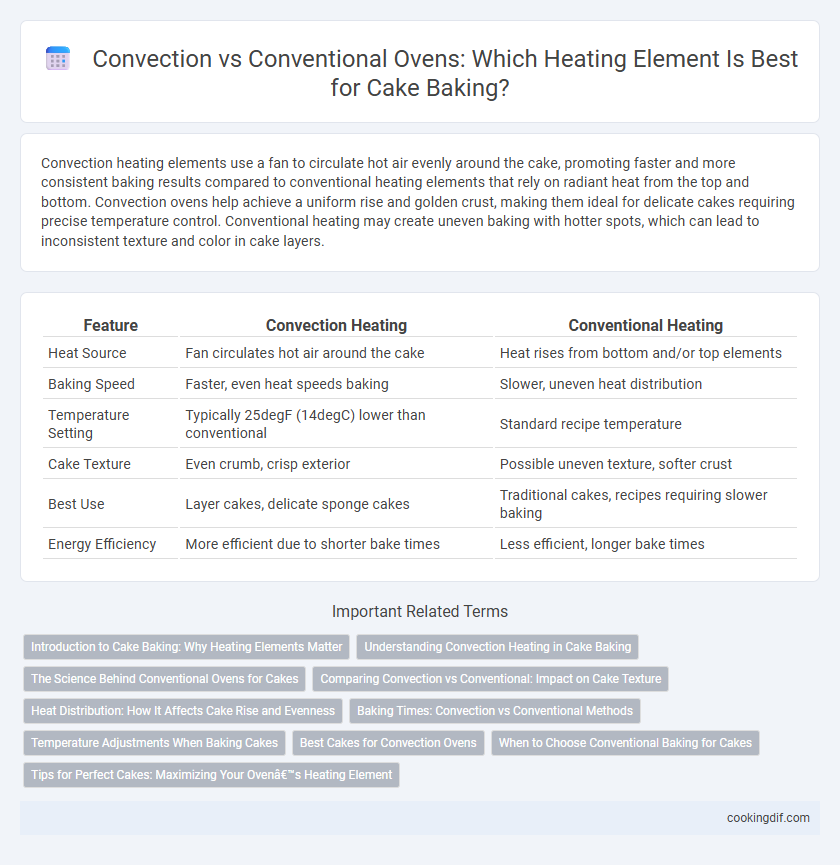Convection heating elements use a fan to circulate hot air evenly around the cake, promoting faster and more consistent baking results compared to conventional heating elements that rely on radiant heat from the top and bottom. Convection ovens help achieve a uniform rise and golden crust, making them ideal for delicate cakes requiring precise temperature control. Conventional heating may create uneven baking with hotter spots, which can lead to inconsistent texture and color in cake layers.
Table of Comparison
| Feature | Convection Heating | Conventional Heating |
|---|---|---|
| Heat Source | Fan circulates hot air around the cake | Heat rises from bottom and/or top elements |
| Baking Speed | Faster, even heat speeds baking | Slower, uneven heat distribution |
| Temperature Setting | Typically 25degF (14degC) lower than conventional | Standard recipe temperature |
| Cake Texture | Even crumb, crisp exterior | Possible uneven texture, softer crust |
| Best Use | Layer cakes, delicate sponge cakes | Traditional cakes, recipes requiring slower baking |
| Energy Efficiency | More efficient due to shorter bake times | Less efficient, longer bake times |
Introduction to Cake Baking: Why Heating Elements Matter
Convection heating elements use a fan to circulate hot air evenly around the cake, promoting uniform baking and a consistent texture. Conventional heating elements rely on direct heat from the top and bottom, which can result in uneven cooking and potential hot spots. Understanding the differences between convection and conventional heating is essential for achieving optimal rise, crumb structure, and moisture retention in cake baking.
Understanding Convection Heating in Cake Baking
Convection heating in cake baking uses a fan to circulate hot air, promoting even heat distribution and faster cooking times compared to conventional heating, which relies on radiant heat from the oven walls. This method reduces hot spots and ensures consistent browning and texture by maintaining uniform oven temperatures. Understanding convection can improve baking outcomes by providing cakes with a moist crumb and evenly risen structure.
The Science Behind Conventional Ovens for Cakes
Conventional ovens use radiant heat from heating elements located at the top and bottom, creating a stable and direct heat source ideal for even browning and crisping of cake surfaces. The absence of a fan results in slower heat circulation, which promotes a delicate crumb structure by allowing gradual, uniform rising and setting of the batter. This heating method is particularly effective for dense or buttery cakes that benefit from steady, enveloping heat without rapid moisture loss.
Comparing Convection vs Conventional: Impact on Cake Texture
Convection ovens use a fan to circulate hot air, promoting even heat distribution that results in cakes with uniform texture and reduced baking time. Conventional ovens rely on static heat, which can cause uneven rising and denser crumb due to localized hot spots. Choosing convection heating improves cake structure by enhancing moisture retention and achieving consistent browning compared to traditional methods.
Heat Distribution: How It Affects Cake Rise and Evenness
Convection heating elements utilize a fan to circulate hot air evenly throughout the oven, promoting uniform heat distribution that enhances cake rise and ensures a consistent crumb texture. Conventional ovens rely on static heat from the top and bottom elements, which can create hot spots leading to uneven rising and potential browning inconsistencies. Even heat distribution from convection baking minimizes the risk of undercooked centers and promotes a more uniform golden crust on cakes.
Baking Times: Convection vs Conventional Methods
Convection baking uses a fan to circulate hot air evenly around the cake, resulting in reduced baking times by approximately 25% compared to conventional baking methods. Conventional ovens rely on radiant heat from heating elements without air circulation, often causing uneven temperature distribution and longer baking periods. Choosing convection baking ensures more consistent heat transfer, promoting faster and more uniform cake cooking.
Temperature Adjustments When Baking Cakes
Convection baking uses a fan to circulate hot air, allowing for more even heat distribution, which typically requires reducing the baking temperature by 25degF (about 15degC) to prevent overbaking or drying out cakes. Conventional ovens rely on radiant heat from the top and bottom elements, necessitating no temperature adjustment but often causing uneven baking with potential hot spots. Accurate temperature control and adjustments in convection ovens enhance cake texture and rise, optimizing moisture retention and browning for superior baking results.
Best Cakes for Convection Ovens
Convection ovens use a fan and exhaust system to circulate hot air evenly, resulting in faster and more uniform baking ideal for cakes with intricate layers, such as chiffon and sponge cakes. The consistent temperature and airflow prevent uneven rising and promote a golden, crisp exterior while maintaining a moist interior. Conventional ovens rely on radiant heat from top and bottom elements, which can cause hot spots, making them less efficient for delicate cakes that require precise temperature control.
When to Choose Conventional Baking for Cakes
Conventional baking is ideal for cakes that require a thick, sturdy crust and a moist, dense interior, such as pound cakes or fruit cakes, because the heating elements provide direct, radiant heat. This method allows for even browning and rising, essential for recipes that involve heavy batters or multiple layers. Choose conventional heating when precision in texture and structure development takes precedence over speed and airflow.
Tips for Perfect Cakes: Maximizing Your Oven’s Heating Element
Convection heating elements circulate hot air evenly, reducing baking time and providing consistent browning for cakes, while conventional heating elements offer a gentler, more radiant heat ideal for delicate textures. To maximize your oven's heating element, adjust rack positions to ensure even airflow in convection ovens and use an oven thermometer to maintain accurate temperatures for both types. Choosing the right heating method and monitoring temperature closely helps achieve cakes with moist interiors and perfectly golden crusts.
Heating elements: Convection vs Conventional for baking method Infographic

 cookingdif.com
cookingdif.com